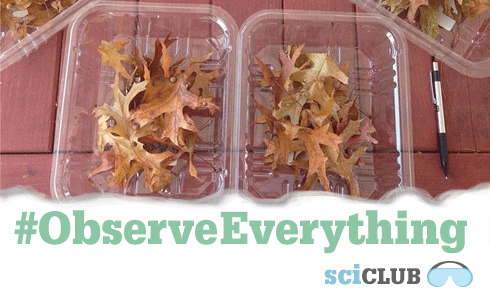Activity Type:
We observe: you're amazing!
Last Friday we invited you to join in our latest Science Club project, #ObserveEverything, and your response has been outstanding. In the past week, you’ve sent us dozens of observations, from family spider tracking around the home to some laser-based photosynthesis research at a major lab. Below are some of our staff favorites from the week’s collection. See all of your submissions in our Science Club gallery, and please keep on observing and posting!
Cloud Timelapse

Bryan Mumford writes: “When we look at clouds, we think of them as drifting slowly across the sky. But sometimes that’s not at all how they move. Santa Barbara lies between the Pacific Ocean and the Santa Ynez Mountains. Often, the clouds I see from my house are not drifting at all, though you would not normally notice. Instead, they condense out of the sea air rising up to the mountains.” You can see the full time lapse video here.
Wasp Galls

Grant Izzo is observing oak leaf galls: “Roughly 1/5 of the oak leaves in my yard have wasp galls…So I decided to set up a little experiment: 10 leaves with galls per container; leaves can have multiple galls; five containers total. I’d like to identify the adults, and if and when they emerge, and what percentage of the galls are successful.”
Bdelloid Rotifer

Bill Dembowski, who has “an insatiable curiosity about the universe and everything in it,” took this picture as part of his project to document the microorganisms found in moss. He identified the specimen as a rotifer in the class Bdelloidea.
Beehive Mites

Gerald Przybylski is an urban beekeeper. He keeps “screen bottom boards” under his beehives, and “most every night we count the varroa mites that fall through the screens onto each ‘counting board,'” he writes. “Those nightly counts, and the daytime high temperature, constitute the data set plotted [here].” The bees represented by the yellow graph received a sugar syrup feeder August 4, 13, 18, and 26, and September 4 and 16. The bees reflected by the brown graph got a sugar syrup feeder August 2 and 20 and September 20. The green graph’s bees had a sugar syrup feeder August 2 and September 21. And finally, the bees represented by the blue graph got a sugar syrup feeder on September 9. “Experts tell us that varroa mites move from one hive to another attached to worker bees that ‘drift’ from one hive to another, or drones that visit any hive they like, or forager bees that rob from other hives,’ he writes. “In the absence of any better explanation, I conclude that drifting and robbing must account for the mite influx. I have an inkling that feeding sugar syrup sometimes reduces the urge to rob. Are other beekeepers experiencing similar invasions of mites? Is feeding a factor?”
Protein Crystallography

These data images were created as part of a series of experiments in protein crystallography in a collaboration among the SLAC National Accelerator Laboratory, Lawrence Berkeley National Laboratory (Berkeley Lab), and the National Energy Research Scientific Computing Center (NERSC). The project hopes to shed new light on the photosynthetic process and demonstrate how light sources and supercomputing facilities can be linked to address emerging challenges in massive data analysis. You can learn more about the project here.
Grasshopper Survey

Sue Meggers writes: “We surveyed our school grounds to determine the number of grasshopper species. The best comment was, ‘I thought there was only one species of grasshopper!’ So far we have identified six species as we discover how difficult it is to identify correctly without a dichotomous key!”

Staff Observations: Ants and Avocados:
Meet the Writer
About Charles Bergquist
As Science Friday’s director and senior producer, Charles Bergquist channels the chaos of a live production studio into something sounding like a radio program. Favorite topics include planetary sciences, chemistry, materials, and shiny things with blinking lights.
